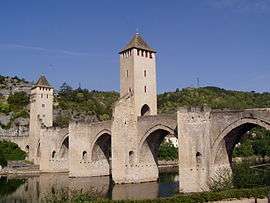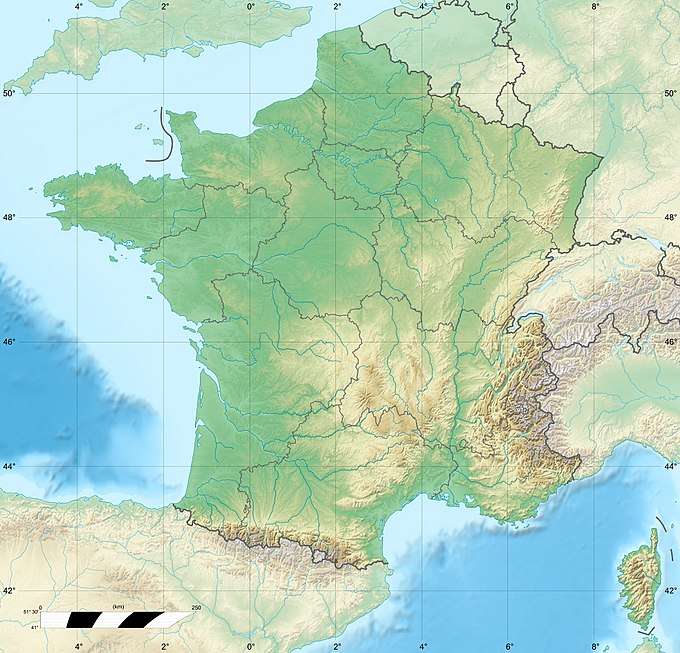Pont Valentré
The Pont Valentré (Occitan: Pont de Balandras; English: Valentré Bridge) is a 14th-century six-span fortified stone arch bridge crossing the Lot River to the west of Cahors, in France. It has become a symbol of the city.
After the decision was made to build it on 30 April 1306, construction began on 17 June 1308.[1] It was built between 1308 and 1378 with six Gothic arches and three square bridge towers.[2] It opened for use in 1350.[1] It was originally fortified at both ends, but the western tower has not survived.[3]
A major restoration was performed from 1867 to 1879 by Paul Gout.[1][3][4]
| Pont Valentré | |
|---|---|
 | |
| Coordinates | 44°26′42″N 1°25′54″E / 44.44500°N 1.43167°ECoordinates: 44°26′42″N 1°25′54″E / 44.44500°N 1.43167°E |
| Crosses | Lot River[1] |
| Locale | Cahors, France |
| Characteristics | |
| Design | arch bridge[1] |
| Material | stone[1] |
| Total length | 138 metres (453 ft)[1] |
| Width | 5 metres (16 ft)[1] |
| Height | 40 metres (130 ft) (towers)[1] |
| Longest span | 6 × 16.5 metres (54 ft)[1] |
| No. of spans | 6 |
| History | |
| Construction start | 17 June 1308[1] |
| Construction end | 1378 |
| Opened | 1350[1] |
 Pont Valentré Location in France | |
The legend of the Pont Valentré
The construction of the bridge lasted 70 years (1308 to 1378). In local folklore it is said that the foreman, exasperated by the slow pace of the work, signed a pact with the Devil. In the pact the Devil promised to use his skills expedite the work and, if he carries out all of the foreman's orders, then his (the foreman's) soul would be forfeit.
Having seen the bridge built on time, the foreman regrets his decision and issues a final order to the devil to go and collect water for the other workers using a sieve. In revenge for having been tricked, the Devil sends a demon each night to loosen the final stone in the central tower (known as the Devil's Tower) to ensure that the bridge is never finished and must be repaired each day
During the restoration of the bridge in 1879, the architect Paul Gout inserted a stone bearing the sculpted image of an imp into the central tower. As a result, according to the updated legend, every time the Devil checks to see that his vandalism has been carried out he is confused into thinking that the stone image is one of his demons tasked with dismantling the bridge..
References
See also
| Wikimedia Commons has media related to Pont Valentré. |